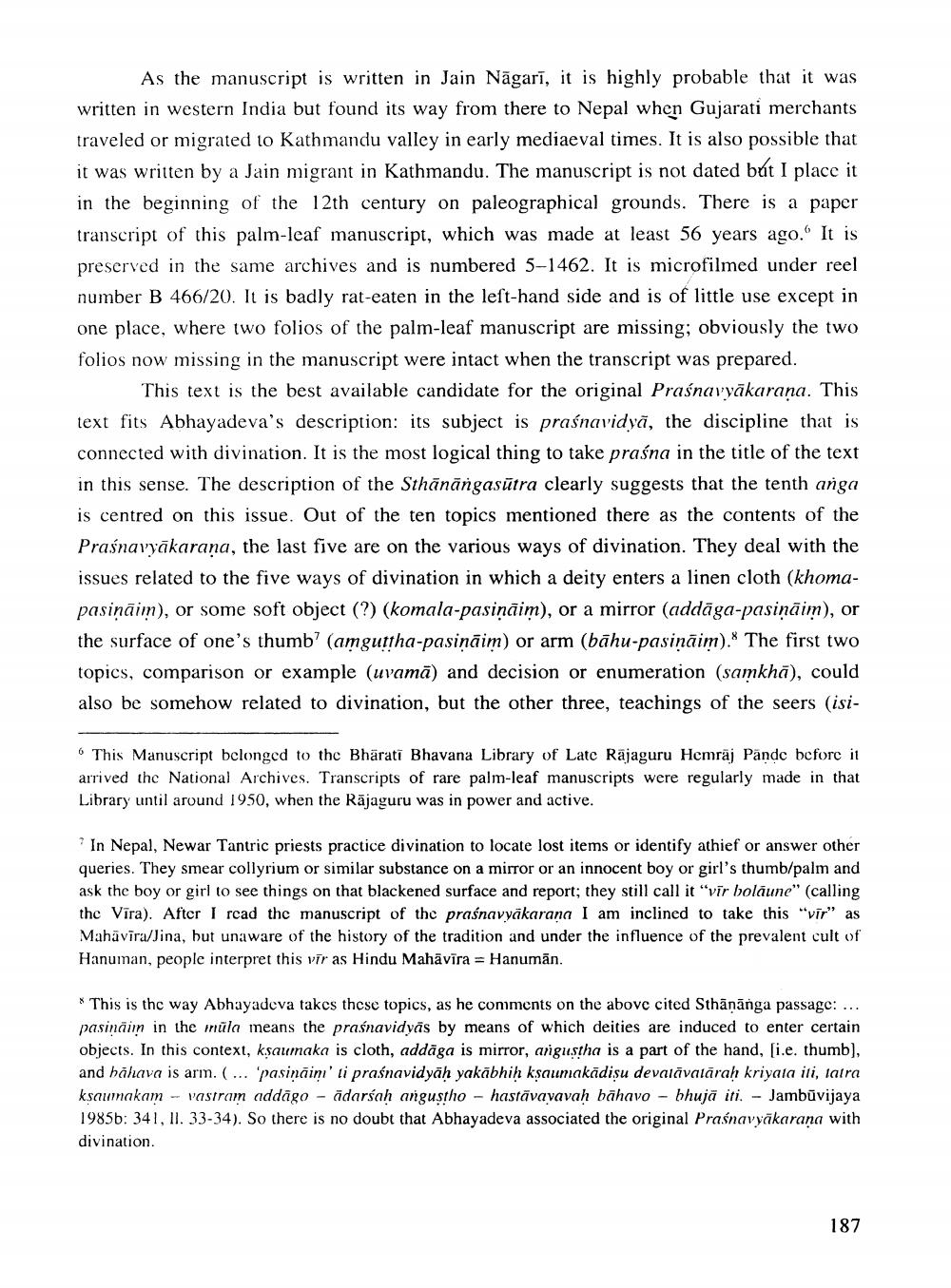________________
As the manuscript is written in Jain Nāgarī, it is highly probable that it was written in western India but found its way from there to Nepal when Gujarati merchants traveled or migrated to Kathmandu valley in early mediaeval times. It is also possible that it was written by a Jain migrant in Kathmandu. The manuscript is not dated but I place it in the beginning of the 12th century on paleographical grounds. There is a paper transcript of this palm-leaf manuscript, which was made at least 56 years ago. It is preserved in the same archives and is numbered 5-1462. It is microfilmed under reel number B 466/20. It is badly rat-eaten in the left-hand side and is of little use except in one place, where two folios of the palm-leaf manuscript are missing; obviously the two folios now missing in the manuscript were intact when the transcript was prepared.
This text is the best available candidate for the original Praśnavyākarana. This text fits Abhayadeva's description: its subject is praśnavidyā, the discipline that is connected with divination. It is the most logical thing to take praśna in the title of the text in this sense. The description of the Sthānāngasūtra clearly suggests that the tenth anga is centred on this issue. Out of the ten topics mentioned there as the contents of the Praśnavyākaraṇa, the last five are on the various ways of divination. They deal with the issues related to the five ways of divination in which a deity enters a linen cloth (khomapasiņāim), or some soft object (?) (komala-pasiņāim), or a mirror (addāga-pasiņāim), or the surface of one's thumb' (amguttha-pasiņāim) or arm (bāhu-pasināim). The first two topics, comparison or example (uvamā) and decision or enumeration (samkhā), could also be somehow related to divination, but the other three, teachings of the seers (isi
This Manuscript belonged to the Bharati Bhavana Library of Late Rajaguru Hemraj Pande before it arrived the National Archives. Transcripts of rare palm-leaf manuscripts were regularly made in that Library until around 1950, when the Räjaguru was in power and active.
? In Nepal, Newar Tantric priests practice divination to locate lost items or identify athief or answer other queries. They smear collyrium or similar substance on a mirror or an innocent boy or girl's thumb/palm and ask the boy or girl to see things on that blackened surface and report; they still call it "vir bolāune" (calling the Vīra). After I read the manuscript of the praśnavyäkarang I am inclined to take this "vir" as Mahāvīra/Jina, but unaware of the history of the tradition and under the influence of the prevalent cult of Hanuman, people interpret this vir as Hindu Mahävīra = Hanumān.
* This is the way Abhayadeva takes these topics, as he comments on the above cited Sthānānga passage: ... pasiņāim in the mula means the praśnavidyās by means of which deities are induced to enter certain objects. In this context, ksaumaka is cloth, addäga is mirror, angustha is a part of the hand, [i.e. thumb), and bāhava is arm. (... 'pasināim' ti praśnavidyāh yakābhih kşaumakādişu devalavatāraḥ kriyala ili, tatra ksaumakam - vastram addīgo - ādarśah angustho - hastāvavavah bāhavo - bhujā iti. - Jambūvijaya 1985b: 341, II. 33-34). So there is no doubt that Abhayadeva associated the original Praśnavyākarana with divination.
187




